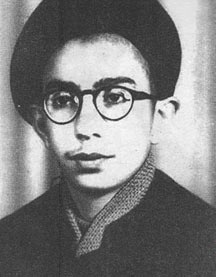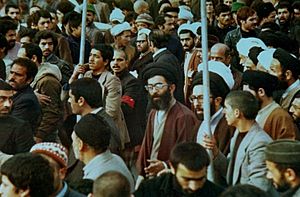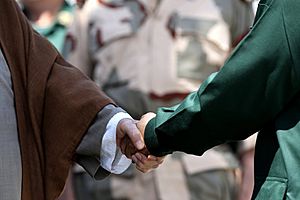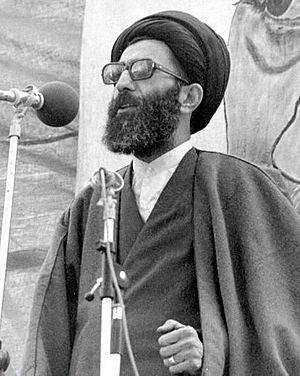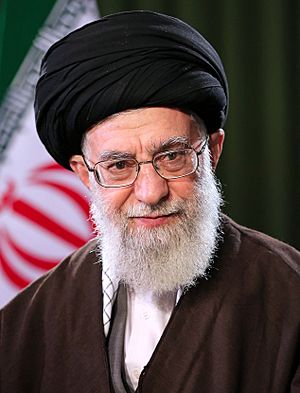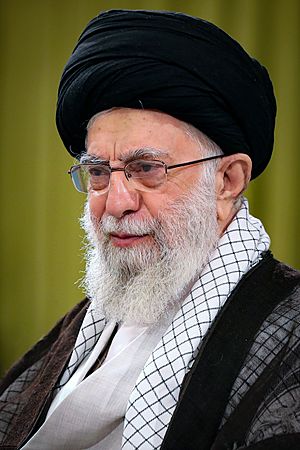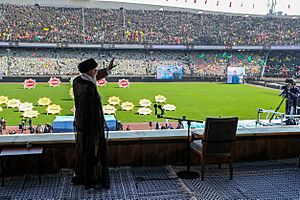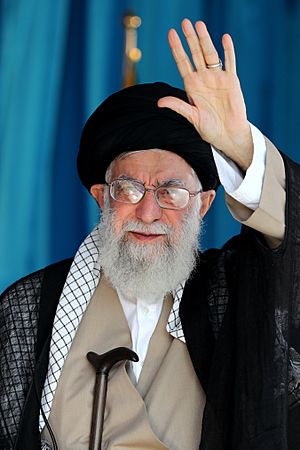Ali Khamenei facts for kids
Quick facts for kids
Ali Khamenei
|
|
|---|---|
|
علی خامنهای
|
|

Khamenei in 2023
|
|
| 2nd Supreme Leader of Iran | |
| Assumed office 6 August 1989 |
|
| President | |
| Preceded by | Ruhollah Khomeini |
| 3rd President of Iran | |
| In office 9 October 1981 – 16 August 1989 |
|
| Prime Minister | Mir-Hossein Mousavi |
| Supreme Leader |
|
| Preceded by | Mohammad-Ali Rajai |
| Succeeded by | Akbar Hashemi Rafsanjani |
| 1st Chairman of the Expediency Discernment Council | |
| In office 7 February 1988 – 4 June 1989 |
|
| Appointed by | Ruhollah Khomeini |
| Preceded by | Office established |
| Succeeded by | Akbar Hashemi Rafsanjani |
| Member of the Assembly of Experts | |
| In office 15 August 1983 – 4 June 1989 |
|
| Constituency | Tehran Province |
| Majority | 2,800,353 (87.8%) |
| Member of the Islamic Consultative Assembly | |
| In office 28 May 1980 – 13 October 1981 |
|
| Constituency | Tehran, Rey and Shemiranat |
| Majority | 1,405,976 (65.8%) |
| Tehran's Friday Prayer Imam | |
| Assumed office 14 January 1980 |
|
| Appointed by | Ruhollah Khomeini |
| Interim Imams |
See list
Ahmad Jannati
Ahmad Khatami Kazem Seddiqi Ali Movahedi-Kermani Mohammad-Hassan Aboutorabi Fard Mohammad Javad Haj Ali Akbari |
| Preceded by | Hussein-Ali Montazeri |
| Personal details | |
| Born |
Sayyid Ali Hosseini Khameneh
19 April 1939 (actual date) 16 July 1939 (certificate date) Mashhad, Khorasan, Imperial State of Iran |
| Political party | Independent (since 1989) |
| Other political affiliations |
|
| Spouse |
Mansoureh Khojasteh Bagherzadeh
(m. 1964) |
| Children | 6, including Mostafa, Mojtaba and Masoud (a.k.a. Mohsen) |
| Parents |
|
| Relatives |
|
| Residence | House of Leadership |
| Alma mater | Qom Seminary |
| Signature | |
| Religion | Islam |
| Denomination | Twelver Shīʿa |
| Alma mater |
|
| Senior posting | |
| Title | Grand Ayatollah |
| Military career | |
| Allegiance | Islamic Republic of Iran |
| Service/ |
|
| Years of service | 1979–1980, 1980–1981 |
| Commands held | Head of Revolutionary Guards |
| Battles/wars |
|
| n.b. | |
Seyyed Ali Hosseini Khamenei (Persian: سید علی حسینی خامنهای, romanized: Ali Hoseyni Xāmene’i born 19 April 1939) is an Iranian Twelver Shia marja' and politician who has been the second supreme leader of Iran since 1989. He previously served as third president of Iran from 1981 to 1989. Khamenei is the longest-serving head of state in the Middle East, as well as the second-longest-serving Iranian leader of the last century, after Shah Mohammad Reza Pahlavi.
As supreme leader, Khamenei is the most powerful political authority in the Islamic Republic. He is the head of state of Iran, the commander-in-chief of its armed forces, and can issue decrees and make the final decisions on the main policies of the government in many fields such as economy, the environment, foreign policy, and national planning in Iran. As supreme leader, Khamenei has either direct or indirect control over the executive, legislative and judicial branches of government, as well as the military and media. All candidates for the Assembly of Experts, the presidency and the Majlis (Parliament) are vetted by the Guardian Council, whose members are selected directly or indirectly by the Supreme Leader of Iran. There have also been instances when the Guardian Council reversed its ban on particular people after being ordered to do so by Khamenei.
There have been major protests during Khamenei's reign, including the 1994 Qazvin protests, the 1999 student protests, the 2009 presidential election protests, the 2011–12 protests, the 2017–18 protests, the 2018–19 general strikes and protests, the 2019–20 protests, the 2021–22 protests, and the Mahsa Amini protests. Journalists, bloggers and others have been imprisoned in Iran for insulting Supreme Leader Khamenei, often in conjunction with blasphemy charges. Their sentences have included lashing and jail time; some have died in custody. Regarding the nuclear program of Iran, Khamenei issued a fatwa in 2003 forbidding the production, stockpiling and use of all kinds of weapons of mass destruction.
Contents
Early life and education
Born to Seyed Javad Khamenei, an Alim and Mujtahid born in Najaf, and Khadijeh Mirdamadi (daughter of Hashem Mirdamadi) in Mashhad, Khamenei is the second of eight children. Two of his brothers are also clerics; his younger brother, Hadi Khamenei, is a newspaper editor and cleric. His elder sister Fatemeh Hosseini Khamenei died in 2015, aged 89. His father was an ethnic Azerbaijani from Khamaneh, while his mother was an ethnic Persian from Yazd. Some of his ancestors are from Tafresh in today's Markazi Province and migrated from their original home in Tafresh to Khamaneh near Tabriz. Khamenei's great ancestor was Sayyid Hossein Tafreshi, a descendant of the Aftasi Sayyids, whose lineage supposedly reached to Sultan ul-Ulama Ahmad, known as Sultan Sayyid, a grandchild of Shia fourth Imam, Ali ibn Husayn.
Education
Khamenei's education began at the age of four, by learning Quran at Maktab; he spent his basic and advanced levels of seminary studies at the hawza of Mashhad, under mentors such as Sheikh Hashem Qazvini and Ayatollah Milani. Then, he went to Najaf in 1957, but soon returned to Mashhad due to his father's unwillingness to let him stay there. In 1958, he settled in Qom where he attended the classes of Seyyed Hossein Borujerdi and Ruhollah Khomeini. Like many other politically active clerics at the time, Khamenei was far more involved with politics than religious scholarship.
Political life and presidency
Khamenei was a key figure in the Iranian Revolution in Iran and a close confidant of Ruhollah Khomeini.
Since the founding of the Islamic Republic, Khamenei has held many government posts.
Muhammad Sahimi claims that his political career began after the Iranian Revolution, when the former President of Iran, Akbar Hashemi Rafsanjani, then a confidant of Khomeini, brought Khamenei into Khomeini's inner circle. Later on, Hassan Rouhani, then a member of Parliament, arranged for Khamenei to get his first major post in the provisional revolutionary government as deputy defense minister.
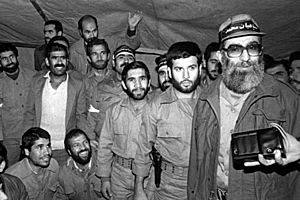
Khomeini appointed Khamenei to the post of Tehran's Friday prayers Imam in 1980, after the resignation of Hussein-Ali Montazeri from the post. He was briefly the vice Minister of National Defence from late July to 6 November 1979 and as a supervisor of the Islamic Revolutionary Guards. He also went to the battlefield as a representative of the parliament's defense commission.
As president
In 1981, after the assassination of Mohammad-Ali Rajai, Khamenei was elected President of Iran by a landslide vote (97%) in the October 1981 Iranian presidential election in which only four candidates were approved by the Council of Guardians. Khamenei became the first cleric to be in the office. Ruhollah Khomeini had originally wanted to keep clerics out of the presidency but later changed his views. Khamenei was reelected in 1985 Iranian presidential election where only three candidates were approved by the Council of Guardians, receiving 87% of the votes. The only Iranian presidential election with fewer candidates approved by the Council of Guardians was the 1989 Iranian presidential election, where only two candidates were approved by the Council of Guardians to run, and Rafsanjani easily won 96% of the votes.
In his presidential inaugural address, Khamenei vowed to eliminate "deviation, liberalism, and American-influenced leftists". According to the Iran Chamber, vigorous opposition to the government, including nonviolent and violent protest, assassinations, guerrilla activity and insurrections, was answered by state repression and terror in the early 1980s, both before and during Khamenei's presidency. Thousands of rank-and-file members of insurgent groups were killed, often by revolutionary courts. By 1982, the government announced that the courts would be reined in, although various political groups continued to be repressed by the government in the first half of the 1980s.
During Iran–Iraq war
Khamenei was one of Iran's leaders during the Iran–Iraq War in the 1980s and developed close ties with the now-powerful Revolutionary Guards. As president, he had a reputation for being deeply interested in the military, budget and administrative details.
After the war
In its 10 April 1997 ruling regarding the Mykonos restaurant assassinations, the German court issued an international arrest warrant for Iranian intelligence minister Ali Fallahian after declaring that the assassination had been ordered by him with knowledge of Khamenei and Rafsanjani. Iranian officials, however, have categorically denied their involvement. The then-Iranian Parliament speaker Ali Akbar Nategh-Nouri dismissed the ruling as political, untrue and unsubstantiated. The ruling led to a diplomatic crisis between the governments of Iran and several European countries, which lasted until November 1997. The accused assassins, Darabi and Rhayel, were finally released from prison on 10 December 2007 and deported back to their home countries.
Supreme Leader
Khamenei has fired and reinstated presidential cabinet appointments. Iran's Chief Justice Sadeq Larijani, a Khamenei appointee, has warned the president of Iran against voicing opposition to Khamenei.
Election as Supreme Leader
In 1989 Ayatollah Khomeini dismissed Ayatollah Montazeri as his political successor, giving the position to Khamenei instead. Because Khamenei was neither a marja or ayatollah, the Assembly of Experts had to modify the constitution to award him the position of Iran's new Supreme Leader (a decision opposed by several grand ayatollahs).
Khamenei officially succeeded Ruhollah Khomeini after Khomeini's death, being elected as the new Supreme Leader by the Assembly of Experts on 4 June 1989.
Leadership Council proposal
Initially, some members of the Assembly of Experts proposed the idea of a leadership council. Various lists were proposed and Khamenei was named in all of them. For instance, a council of three members, Ali Meshkini, Mousavi Ardebili and Khamenei, was proposed to lead Iran. According to Rafsanjani, he and Khamenei were against the proposal, while Ayatollah Haeri Shirazi and Ayatollah Ebrahim Amini were in favor of it. Supporters of the council proposal believed that having a council would produce a higher degree of unity in society and more positive characteristics would be found in a council. In contrast, the opposers believed that an individual leader was more efficient according to past experiences in the case of the Judiciary Council.
Ebrahim Amini listed the summary of the reasons presented by the two sides. According to him, the opposers rejected the proposal because i) Evidence for Guardianship of the Islamic Jurist was true only for the guardianship of an individual and it was not clear who held the guardianship when there was a council. The guardianship of a council was not rooted in Hadiths and Islamic jurisprudence. ii) Previous council-type organizations, such as the broadcasting council and supreme judicial council, were not successful in practice and the leadership council would not do well for similar reasons. iii) People were accustomed to the leadership of an individual and a council of leaders was something unfamiliar to them. iv) An individual leader could act more decisively when dealing with critical and essential decisions and solving problems and crisis. On the other hand, the supporters of the proposal believed that: i) At the time, there were no Faqih equal to Khomeini or even two or three levels lower than him so that he could fulfill the expectation of people. ii) In the case of a council of leaders, the members could compensate each other, if any of them had some shortage in a field.
Finally, 45 members voted against the leadership council proposal while more than 20 people were in favor of it and the proposal was rejected. After the assembly rejected the idea of a Leadership Council, Khamenei was elected Leader by 60 of the 74 members present with Grand Ayatollah Mohammad-Reza Golpaygani receiving the remaining 14 votes. Khamenei made protestations of his unworthiness -- "my nomination should make us all cry tears of blood" and debated with the mujtahids of the Assembly—but eventually accepted the post.
Marjaʿiyyat criteria
Since Khamenei was not a marja' at the time—which the Iranian constitution required—he was named as the temporary Supreme Leader. Later, the constitution was amended to remove that requirement and the Assembly of Experts reconvened on 6 August 1989, to reconfirm Khamenei with 60 votes out of 64 present. On 29 April 1989, responding to the letter of Ayatollah Meshkini, the head of committee responsible for revising the Constitution, asking Khomeini's viewpoint regarding the 'marjaʿiyyat criteria, Khomeini said: "From the very beginning, I believed and insisted that there is no need for the requirements of marjaʿiyyat (authority in jurisprudence). A pious mujtahid (jurist-intellectual), who is approved by the esteemed Assembly of Experts (Majlis-i Khobregan), will suffice." In a video that surfaced during the 2017–18 Iranian protests, Khamenei is seen before the assembly said he was not religiously qualified to be a Supreme leader. Khamenei, who was ranked as a Hujjat al-Islam and not a Marja' as required by the Iranian constitution, said he would only be a "ceremonial leader", and was reassured by Akbar Hashemi Rafsanjani the position would be "temporary" until a referendum, apparently planned for one year later.
On August 29, 2022, al-Haeri announced his resignation from the position of Marja, due to old age and illness. This was described as the first time in history a Marja has ever resigned from his position. He called on his followers to follow Ali Khamenei, Supreme Leader of Iran as "the best person for the leadership of our people and removing the aggressors".
Political strategy and philosophy
Khamenei issues decrees and makes the final decisions on the economy, environment, foreign policy and everything else in Iran. Khamenei regularly meets with the president, cabinet members, head and officials of the judiciary branch, parliamentarians, among others, and tells them what to do. Khamenei has also fired and reinstated presidential cabinet appointments. Khamenei meets with foreign dignitaries, however, he does not travel overseas; if anyone wishes to see him, that person must travel to Iran. Apart from his time in Najaf as a student, Khamenei traveled to Libya during his time as president.
In his speeches, Khamenei regularly mentions many familiar themes of the 1979 revolution: justice, independence, self-sufficiency, Islamic government and resolute opposition to Israel and the United States, while rarely mentioning other revolutionary ideals such as democracy and greater government transparency. According to Karim Sadjadpour of the Carnegie Endowment for International Peace, Khamenei has "resisted Rafsanjani's attempts to find a modus vivendi with the United States, Khatami's aspirations for a more democratic Islamic state, and Ahmadinejad's penchant for outright confrontation."
Domestic policy
Some regard Khamenei as the figurehead of the country's conservative establishment.
Khamenei supported Mesbah Yazdi, describing him as one of Iran's most credible ideologues before the 2005 election, but has reportedly "recently been concerned about Mesbah's political ambitions."
In 2007, Khamenei requested that government officials speed up Iran's move towards economic privatization. Its last move towards such a goal was in 2004 when Article 44 of the constitution was overturned. Article 44 had decreed that Iran's core infrastructure should remain state-run. Khamenei also suggested that ownership rights should be protected in courts set up by the Justice Ministry; the hope was that this new protection would give a measure of security to and encourage private investment. In 2007, Iranian police under the direction of Khamenei launched a "Public Security Plan", arresting dozens of "thugs" to increase public security.
Additionally, Khamenei has stated that he believes in the importance of nuclear technology for civilian purposes because "oil and gas reserves cannot last forever."
On 30 April 2008, Ali Khamenei backed President Ahmadinejad's economic policy and said the West was struggling with more economic difficulties than Iran, with a "crisis" spreading from the United States to Europe, and inflation was a widespread problem. The Iranian leader said that the ongoing economic crisis which has debilitated the world has been unprecedented in the past 60 years. "This crisis has forced the UN to declare state of emergency for food shortages around the globe but foreign radios have focused on Iran to imply that the current price hikes and inflation in the country are the results of carelessness on the part of Iranian officials which of course is not true", he said. Khamenei emphasized that no one has the right to blame the Iranian government for Iran's economic problems. He also advised people and the government to be content and avoid waste in order to solve economic problems. "I advise you to keep in your mind that this great nation is never afraid of economic sanctions", he added.
Science and technology
Ali Khamenei has been supportive of scientific progress in Iran. He was among the first Islamic clerics to allow stem cell research and therapeutic cloning. In 2004, Khamenei said that the country's progress is dependent on investment in the field of science and technology. He also said that attaching a high status to scholars and scientists in society would help talents to flourish and science and technology to become domesticated, thus ensuring the country's progress and development.
Minorities
The Baháʼí Faith is the largest religious minority in Iran, with around 300,000 members (8,000,000 members worldwide) and is officially considered a dangerous cult by the Iranian government. It is banned in Iran and several other countries. Khamenei has approved new legislation against Baháʼís in Iran and lessen their influence abroad. According to a letter from the Chairman of the Command Headquarters of the Armed Forces in Iran addressed to the Ministry of Information, the Revolutionary Guard, and the Police Force, Khamenei has also ordered the Command Headquarters to identify people who adhere to the Baháʼí Faith and to monitor their activities and gather any and all information about the members of the Baháʼí Faith.
Gender issues
In July 2007, Khamenei criticized Iranian women's rights activists and the Convention on the Elimination of All Forms of Discrimination Against Women (CEDAW): "In our country ... some activist women, and some men, have been trying to play with Islamic rules to match international conventions related to women", Khamenei said. "This is wrong." Khamenei made these comments two days after Iranian women's rights activist Delaram Ali was sentenced to 34 months of jail and ten lashes by Iran's judiciary.
Khamenei advocates the Islamic practice of Hijab. He believes that hijab is aimed at honoring women.
Ali Khamenei believes in gender segregation.
On LGBT issues, Khamenei has said: "Today, homosexuality is a major problem in the Western world. They [western nations], however ignore it. But the reality is that homosexuality has become a serious challenge, pain and unsolvable problem for the intellectuals in the west."
Human rights, freedoms, protests, Islamic law
Critics have accused Khamenei of overseeing the assassination of as many as 160 exiled defectors worldwide, the heavy-handed repression of protesters, the killings of tens of thousands of members of the M.E.K. (People's Mujahedin of Iran) paramilitary group, and of making dissident writers and intellectuals in Iran "a special target" of repression, among other infractions of human rights.
Protests during leadership

There have been several major protests during Khamenei's reign, including the 1994 Qazvin Protests—where, according to Al-Arabiya, around 40 people were killed and over 400 were injured— the 1999 Iranian student protests, the 2009 Iranian presidential election protests, when protesters chanted "death to the dictator", and ripped down pictures of Khamenei, as well as the 2011–12 Iranian protests and 2017–18 Iranian protests, among others. In 2016, Khamenei, who outlined the elections guidelines "in line with Article 110 of Iran's Constitution", asked to maximize the amount of transparency in elections in Iran, using modern technologies.
During the Mahshahr massacre, protests expanded against "government corruption, failing institutions, lack of freedoms and the repressive rule of Iran's supreme leader, Ayatollah Ali Khamenei."
During the 2018–2019 Iranian general strikes and protests, Khameini demanded punishment for those "who disrupt economic security". According to Reuters, the remarks were "clearly intended to send a message to Iranians who may plan more demonstrations".
During the 2019–2020 Iranian protests, Khamenei met with various officials and cabinet members, saying "he would hold the assembled officials responsible for the consequences of the protests if they didn't immediately stop them." According to an official, Khamenei "made clear the demonstrations required a forceful response" and that "rioters should be crushed."
Personal life
Family
Khamenei is married to Mansoureh Khojasteh Bagherzadeh, with whom he has six children; four sons (Mostafa, Mojtaba, Masoud, and Meysam) and two daughters (Boshra and Hoda). One of his sons, Mojtaba, married a daughter of Gholam-Ali Haddad-Adel. His eldest son, Mostafa, is married to a daughter of Azizollah Khoshvaght. Another son, Masoud, is married to the daughter of Mohsen Kharazi. He has three brothers, including Mohammad Khamenei and Hadi Khamenei. One of his four sisters, Badri Hosseini Khamenei (wife of dissident Ali Tehrani), fled into exile in the 1980s.
Home
As Supreme Leader, Khamenei moved to a house in Central Tehran on Palestine Street. A compound grew around it that now contains around fifty buildings. Around 500 people are employed at this "Beit Rahbari compound" according to The Telegraph, "many recruited from the military and security services".
Lifestyle
According to Mehdi Khalaji, an Iran expert at the Washington Institute for Near East Policy, Khamenei has a decent life "without it being luxurious". Robert Tait of The Daily Telegraph commented that Khamenei is "renowned for a spartan lifestyle." Dexter Filkins describes Khamenei as presenting himself "as an ascetic, dressing and eating simply". In an interview with a women's magazine, his wife declared that "we do not have decorations, in the usual sense. Years ago, we freed ourselves from these things." On the other hand, Mother Nature Network claims Khamenei has been seen riding around in a BMW car and published a picture of him exiting one. In a 2011 report in The Daily Telegraph, defectors from Iran claimed Khamenei has a considerable appetite of caviar and trout, a stable of 100 horses, collects items such as pipes and (reputedly) 170 antique walking sticks, and has a private court stretching over six palaces. Intelligence sources have also said his family has extensive international business interests.
Health
Khamenei's health has been called into question. In January 2007, rumors spread of his illness or death after he had not been seen in public for some weeks and had not appeared as he traditionally does at celebrations for Eid al-Adha. Khamenei issued a statement declaring that "enemies of the Islamic system fabricated various rumors about death and health to demoralize the Iranian nation", but according to the author Hooman Majd, he appeared to be "visibly weak" in photos released with the statement.
On 9 September 2014, Khamenei underwent prostate surgery in what his doctors described in state news media as a "routine operation". According to a report by Le Figaro, Western intelligence sources said Khamenei has prostate cancer.
In September 2022, it was reported that Khamenei had undergone surgery for bowel obstruction and had to cancel a number of meetings.
Sanctions
On 24 June 2019, the United States imposed sanctions on Khamenei with the signing of Executive Order 13876.
Literature and art
In late 1996, following a fatwa by Khamenei stating that music education corrupts the minds of young children and is against Islam, many music schools were closed and music instruction to children under the age of 16 was banned by public establishments (although private instruction continued).
Khamenei has stated that "poetry must be the vanguard of the caravan of the [Islamic] revolution... [T]hrough the arts and literature, the revolution can be exported more easily and honestly." It has been suggested (by Dexter Filkins) that this might explain his interest in banning books, prohibiting newspapers and imprisoning artists. He has expressed interest in studying novels and stories since childhood and studied various world's credible novels. He was "fascinated by Jean-Paul Sartre and Bertrand Russell" in his youth. He praised the works of Mikhail Sholokhov, Alexei Tolstoy, Honoré de Balzac, and Michel Zévaco. However, Victor Hugo's Les Misérables "is the best novel that has been written in history." He explained:
I've read The Divine Comedy. I have read Amir Arsalan. I have also read A Thousand and One Nights ... [But] Les Misérables is a miracle in the novel writing world... I have repeatedly said, go read Les Misérables once. This Les Misérables is a book of sociology, a book of history, a book of criticism, divine book, a book of love and feeling.
He suggested reading The Grapes of Wrath to "an audience of writers and artists" and Uncle Tom's Cabin to the high-level state managers as he thought it shed light on the history of the United States.
Isn't this the government that massacred the original native inhabitants of the land of America? That wiped out the American Indians? ... Today, one of the most tragic works of art is Uncle Tom's Cabin ... This book still lives after almost 200 years,
Khamenei is fluent in Arabic in addition to his native languages, Persian and Azerbaijani. He has translated several books into Persian from Arabic, including the works of the Egyptian Islamic theoretician Sayyid Qutb.
When it comes to poetry, in Mashhad he used to participate in literary associations along with known poets and used to critique poems. Writing some poems himself, he chose the pseudonym 'Amin' for himself.
In the field of music, he is known to have a good singing voice and plays the tar, a traditional Iranian stringed instrument.
Works
- Four main books of Rijal
- An Outline of Islamic Thought in the Quran
- Honest leader
- Discourse on Patience (translation by Sayyid Hussein Alamdar available online)
- Iqbal: Manifestation of the Islamic Spirit, Two Contemporary Muslim Views ISBN: 1-871031-20-6
- Iqbal, the Poet-Philosopher of Islamic Resurgence is one of the "Two Contemporary Muslim Views", the other one is Ali Shariati's.
- Replies to Inquiries about the Practical Laws of Islam ISBN: 964-472-000-8 (PDF version)
- Lessons from the Nahjul-Balaghah
- Human Rights in Islam
- The Charter of Freedom
- Essence of Tawhid: Denial of Servitude but to God
Translations from Arabic:
- Future in the realm of Islam
Collections:
- A 250 Years Old Person
- Palestine
Images for kids
-
Khamenei and former president Akbar Hashemi Rafsanjani
-
Khamenei with Mahmoud Ahmadinejad, Ali Larijani, and Sadeq Larijani in 2011
-
Khamenei meeting with Hajj authorities, 2018
-
Khamenei in meeting with Russian President Vladimir Putin, 23 November 2015
-
Khamenei meeting with his counterpart, China's paramount leader Xi Jinping, 23 January 2016
-
Khamenei with former Swedish Prime Minister Stefan Löfven, 11 February 2017
-
Pro-government Syrians with portraits of Assad, Ayatollah Khomeini and Khamenei, April 2018
-
Khamenei with Turkish President Recep Tayyip Erdoğan in Tehran, 7 September 2018
See also
 In Spanish: Alí Jamenei para niños
In Spanish: Alí Jamenei para niños


